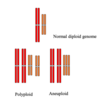Genetics 10 - Cancer & Genomic Medicine (lessons) Flashcards
(69 cards)
learning outcomes

neoplasm
an abnormal mass of tissue unresponsive to normal growth controls
neoplastic cells have clonally expanded as a result of somatic mutation
BENIGN - uncontrolled growth of tumour, but cannot metastasize
MALIGNANT - acquired ability to metastasize (seed other places)
cell growth/division
Cancer is closely linked to cell cycle
Most cancers have inactivating mutations in 1+ proteins that normally function to restrict progression through G1 phase of cell cycle
Virtually all human tumours have inactivating mutations in proteins - p53 - stopping cell if previous step has occurred incorrectly or DNA has been damaged
Growth factors
Growth factor receptors
Signal transduction proteins
Transcription factors
Pro and anti apoptotic proteins
Cell cycle control proteins

hallmarks of cancer
progressive
not overnight - changes accumulate

role of oncogene
developed from protooncogene
accelerator
genes involved in growth, proliferation, cell cycle
tyrosine kinases (Src, ABL)
growth factors (PDGF-B)
receptor tyrosine kinases (ERBB2, EGFR, HER2/neu)
IC signalling cascade components (Ras)
cell cycle regulators (Myc)
role of TSGs
brakes
gatekeeper genes
APC - familial colon cancer
RB1 - retinoblastoma
inhibits tumour growth, proliferation or cell cycle progression
caretaker genes
stability genes
MLH1
MSH2
stabilise the genome (provide mutational (DNA repair) or chr stability)
oncogene
a gene that when expressed confers resistance to programmed cell death
protooncogene
can become an oncogene following
point mutation
chromosomal translocation
increase in gene expression e.g. change in promoter
protooncogene to oncogene - type of mutation
change in just 1 of 2 alleles may result in malignant transformation e.g. epidermal growth factor (EGFR)
dominant activating/hypermorphic (GOF) mutation

tumour suppressor genes - what do they code for
products of this family of genes regulate cell cycle or direct cells towards apoptosis - code for:
- proteins that repress expression of genes essential for continuation of cell cycle
- proteins that prevent cell cycle progression in presence of damaged DNA
- proteins that promote apoptosis if DNA is damaged
- proteins that promote cell adhesion (prevent metastasis)
- proteins involved in DNA repair

2 hit hypothesis - type of mutation
typically need change in both alleles for malignant transformation
recessive amorph/hypomorphic (LOF) mutations
Probability of 1 cell being hit is high - especially if it’s a large cell
2nd hit is unlikely

big TS gene
size
activity depends on…
function
protein - p53
gene is TP53 on chr 17 (17p13.1)
393 AAs
activity depends on forming a tetramer
multiple TS functions - growth arrest, apoptosis, DNA repair

hereditary mutation associated with TP53
Li-Fraumeni Syndrome
rare but highly penetrant
can result in tumorigenesis in different places
mutation in core domain of TP53

mutation in C terminal of TP53
type of mutation
No tetramer formed
Interferes with normal protein folding - binds in an abhorrent fashion
Monoallelic change is enough
Dominant negative mutation - antimorph
Protein with a no of subunits and a mutation in 1 allele means the tetramer cannot form properly to carry out its function

Vogelstein’s tumour progression model
e.g. Colorectal cancer
10 years to get to carcinoma stage
More and more mutations over time
Initially in DNA repair genes, TSGs, built up to oncogenes which acecelerated tumorigenesis - loss of p53 can lead to chromosomal aneuploidy
CA = change no of chromosomes in the cell - increases dysplasia (presence of abnormal cells within a tissue)

life time risk of BC
molecular progression of BC is complex
different subtypes arising from different pathways

histology of BC

sporadic BC - risk factors
female gender
oestrogen exposure
age of menarche/menopause (<12/>55)
reproductive Hx
exposure to exogenous oestrogens
alcohol, obesity, radiation exposure
null parity
having 1st child > 35
sporadic vs familial BC
majority of BC is sporadic
family history of BC not synonymous with hereditary BC
13% of women have family history of BC but most do not get BC
what does oestrogen do
fuels growth and division of cancer cells, especially those with oestrogen receptors




























